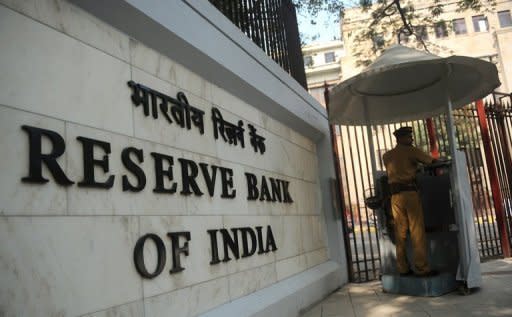India cuts rates by 50 basis points to spur growth
India's central bank lowered interest rates for the first time in three years Tuesday, springing a bigger-than-forecast cut of 50 basis points along with a warning that further easing will be difficult. Seeking to spur faltering growth, the central bank said the benchmark repo rate, at which it lends to commercial banks, would fall to 8.0 percent and the reverse repo rate, which it pays banks for deposits, would fall to 7.0 percent. "The reduction in the repo rate is based on an assessment of growth having slowed," Reserve Bank of India governor Duvvuri Subbarao said. The central bank hiked interest rates 13 times from March 2010, undertaking the most aggressive monetary policy tightening drive of all major economies. Rates have been on hold since late last year. The stock markets cheered the rate cut, with the benchmark 30-share Sensex index comprising blue-chips gaining in afternoon trade to end up 1.21 percent at 17,357.94 points. The economic outlook "should now improve," said Finance Minister Pranab Mukherjee, promising the government would take "additional steps to further reimpose the focus of growth" in coming weeks. Business leaders have been clamouring for interest rates to be reduced to boost the economy, expected by the government to grow 6.9 percent in the financial year just ended, its slowest pace since the 2008 financial crisis. The bank's decision comes as India's inflation climbed unexpectedly in March to 6.89 percent, data showed on Monday, fuelled by rises in food and fuel prices. Subbarao said that inflation, though on a downtrend, remains "challenging", amid rising crude oil prices and growing geo-political tensions. "These considerations inherently limit the space for further reduction in policy rates," Subbarao said of inflation risks. "It will all depend on how growth pans out," he told reporters later in the day. Industry heads welcomed the larger-than-expected cut. "The repo rate cut will provide the boost to investment as well as send a strong signal that turning around growth is of pivotal importance," said Chandrajit Banerjee, director general of the Confederation of Indian Industry. Emerging market nations have been cutting rates to bolster expansion and shield their economies from Europe's sovereign debt crisis as well as the weakened US economy and to offset a slowdown in China. In a preliminary step to loosening monetary policy, the RBI twice reduced the amount of cash commercial banks must keep in reserve since the start of the year in a bid to boost lending and spur growth. Subbarao forecast India's growth in the new financial year, which started April 1, at 7.3 percent, slightly below the government's estimate of 7.6 percent. This is still far below the eight-to-nine percent growth for much of the past decade. India's slowing growth comes as the Congress party-led government, battered by a string of graft scandals, has been under heavy financial market pressure to curb public spending and rein in a ballooning deficit. India's projected growth remains enviable by Western standards but it is too slow to fulfil government pledges of significant poverty reduction and to create enough jobs for a soaring young workforce in the country of 1.2 billion.



